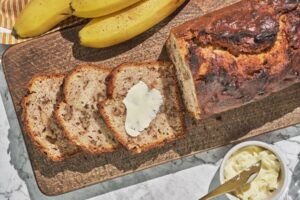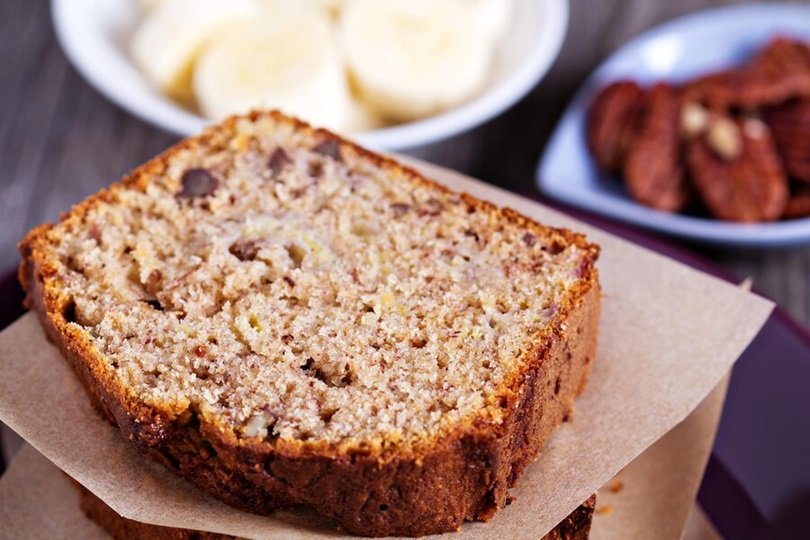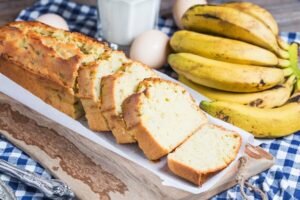Banana bread is one of those timeless comfort foods that bring warmth and joy to any kitchen. Its rich, moist texture and sweet, tender flavor make it an irresistible treat for breakfast, snacks, or even dessert. Whether you’re a seasoned baker or just starting, this banana bread recipe is simple, quick, and delicious, guaranteed to become a family favorite.
In this article, we’ll walk you through the steps of creating the perfect banana bread, highlight important tips, and provide answers to common questions. Get ready to bake the most delicious loaf of banana bread!
Table of Contents
- Ingredients Needed for Banana Bread
- Step-by-Step Instructions for Banana Bread
- Tips for Perfect Banana Bread
- How to Customize Your Banana Bread
- Common Mistakes to Avoid
- Banana Bread Variations
- Banana Bread FAQ
- Summary
Ingredients Needed for Banana Bread Recipe
Banana bread requires just a few simple ingredients. Ripe bananas are the star of the show, so make sure to choose bananas that are well beyond the point of being eaten raw. They should have brown spots on their skins to provide the natural sweetness needed for the bread.
Here’s the list of ingredients for the perfect banana bread:
| Ingredient | Amount |
|---|---|
| Ripe Bananas | 3-4 medium |
| All-Purpose Flour | 2 cups |
| Baking Soda | 1 teaspoon |
| Salt | 1/2 teaspoon |
| Butter (unsalted) | 1/2 cup (113g) |
| Sugar | 3/4 cup (150g) |
| Egg | 1 large |
| Vanilla Extract | 1 teaspoon |
| Sour Cream or Yogurt | 1/4 cup (60g) |
| Optional Add-ins | 1/2 cup chopped nuts, chocolate chips, or dried fruit |
Make sure that the butter is softened at room temperature for easy mixing, and the eggs should be at room temperature too.
Step-by-Step Instructions for Banana Bread Recipe
Now, let’s dive into the method for baking your banana bread. Follow these simple instructions for a soft, moist loaf every time.
Step 1: Prepare the Oven and Pan
Start by preheating your oven to 350°F (175°C). Grease a 9×5-inch loaf pan with butter or non-stick spray to prevent the bread from sticking. You can also line the pan with parchment paper for easy removal.
Step 2: Mash the Bananas
Take your ripe bananas and peel them. Using a fork or potato masher, mash the bananas in a large bowl until you have a smooth, slightly chunky consistency. This is the base of your banana bread and will give it that lovely, moist texture.
Step 3: Mix the Wet Ingredients
In a separate bowl, cream together the softened butter and sugar until light and fluffy. This should take about 2 minutes with an electric mixer on medium speed. Add in the egg, vanilla extract, and sour cream or yogurt, and mix well.
Once the wet ingredients are fully combined, fold in the mashed bananas and mix until the batter is smooth.
Step 4: Combine Dry Ingredients
In another bowl, whisk together the all-purpose flour, baking soda, and salt. It’s important to sift the dry ingredients to avoid lumps and ensure an even rise.
Step 5: Add Dry Ingredients to Wet Mixture
Gradually fold the dry ingredients into the wet ingredients. Mix gently with a spatula or wooden spoon until everything is just combined. Be careful not to over-mix, as this can result in dense banana bread.
Step 6: Bake the Banana Bread
Pour the batter into the prepared loaf pan and smooth the top with a spatula. Bake for 60-65 minutes or until a toothpick inserted in the center comes out clean. If you notice the bread is browning too quickly, you can loosely cover it with aluminum foil during the last 20 minutes of baking.
Step 7: Cool and Serve
Allow the banana bread to cool in the pan for about 10 minutes before transferring it to a wire rack to cool completely. Slice and serve your delicious homemade banana bread.
Tips for Perfect Banana Bread Recipe

To make your banana bread extra special, here are some important tips to keep in mind:
- Use very ripe bananas: Overripe bananas are essential for the best flavor and texture. They provide natural sweetness and moisture.
- Don’t over-mix the batter: Overmixing can lead to dense bread. Mix until just combined.
- Add-ins are optional: Feel free to add chocolate chips, chopped nuts (like walnuts or pecans), or dried fruits for added texture and flavor.
- Use room temperature ingredients: Always bring your butter and eggs to room temperature for better mixing and smoother batter.
- Test for doneness: Insert a toothpick into the center of the bread; it should come out clean when it’s done. If the top is golden but the bread is still raw inside, cover with foil and bake for an additional 10-15 minutes.
How to Customize Your Banana Bread
While the classic banana bread recipe is a crowd-pleaser, you can easily customize it to suit your taste or dietary needs. Here are some ideas:
- Gluten-Free Banana Bread: Replace the all-purpose flour with a gluten-free flour blend. Make sure to check that the other ingredients, such as baking soda, are also gluten-free.
- Vegan Banana Bread: Swap the butter with coconut oil or vegetable oil, and use a flax egg (1 tablespoon flax meal mixed with 3 tablespoons water) instead of the egg.
- Healthy Banana Bread: Reduce the sugar amount or substitute it with honey, maple syrup, or a sugar alternative. You can also use whole wheat flour instead of all-purpose flour for added fiber.
- Banana Nut Bread: Add 1/2 cup of chopped walnuts or pecans for a nutty crunch.
- Chocolate Banana Bread: Stir in 1/2 cup of mini chocolate chips to the batter for a sweet, indulgent twist.
Common Mistakes to Avoid
Even the best bakers can make a few mistakes when it comes to banana bread. Here’s how to avoid them:
- Not using ripe enough bananas: If your bananas aren’t fully ripe, your banana bread won’t be as flavorful or sweet.
- Overmixing the batter: Overmixing can lead to tough, dense banana bread.
- Baking at the wrong temperature: Baking at too high a temperature may cause the outside to brown too quickly while leaving the inside raw. Always bake at the correct temperature and check with a toothpick.
- Not cooling the bread completely: Let your banana bread cool for at least 30 minutes before slicing. This helps it set properly and prevents it from becoming mushy.
Banana Bread Variations
Banana bread can be made in many different ways. Some popular variations include:
- Zucchini Banana Bread: Add grated zucchini for extra moisture and nutrients.
- Peanut Butter Banana Bread: Swirl in some peanut butter for a delicious savory twist.
- Carrot Banana Bread: Add shredded carrots for a vegetable-packed version of banana bread.
- Spiced Banana Bread: Add cinnamon, nutmeg, and cloves for a warming spiced version of banana bread.
Banana Bread FAQ
1. Can I freeze banana bread?
Yes, you can freeze banana bread! Once it’s completely cool, wrap it tightly in plastic wrap and then foil, and place it in the freezer for up to 3 months. To thaw, simply let it sit at room temperature for a few hours or warm it in the oven.
2. How do I make banana bread more moist?
Make sure you use ripe bananas, as they contribute to the moisture. Additionally, adding sour cream or yogurt helps retain moisture. Avoid overmixing the batter and bake at the correct temperature.
3. Can I use frozen bananas?
Yes, you can use frozen bananas for banana bread. Just thaw them and drain any excess liquid before mashing them.
4. Can I use self-raising flour for banana bread?
If you use self-raising flour, you’ll need to omit the baking soda and adjust the amount of salt in the recipe since self-raising flour already contains these leavening agents.
5. How long should banana bread cool before slicing?
It’s best to let banana bread cool for about 30 minutes before slicing. This ensures the texture sets properly and prevents it from falling apart when you cut it.
Summary
Banana bread is a delicious, versatile treat that’s easy to make with a few simple ingredients. By following this step-by-step guide, you can bake the perfect loaf every time, whether you’re making it classic or experimenting with variations. Enjoy the aroma of freshly baked banana bread and savor each delicious bite!
Disclaimer Note
This banana bread recipe is for general informational purposes only. All recommendations are based on common cooking practices, and the outcomes may vary depending on individual kitchen conditions. Always consult your kitchen appliances’ manuals and ingredient labels for accurate measurements and instructions.















